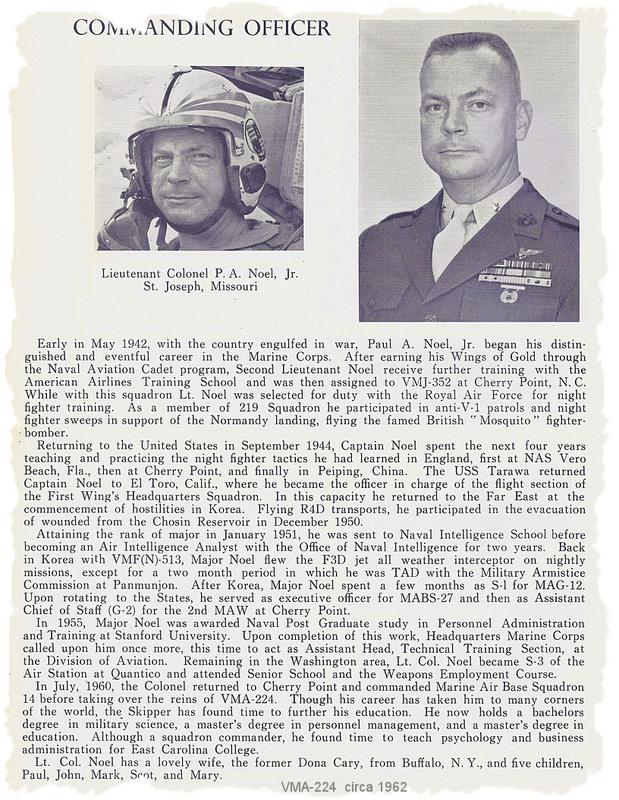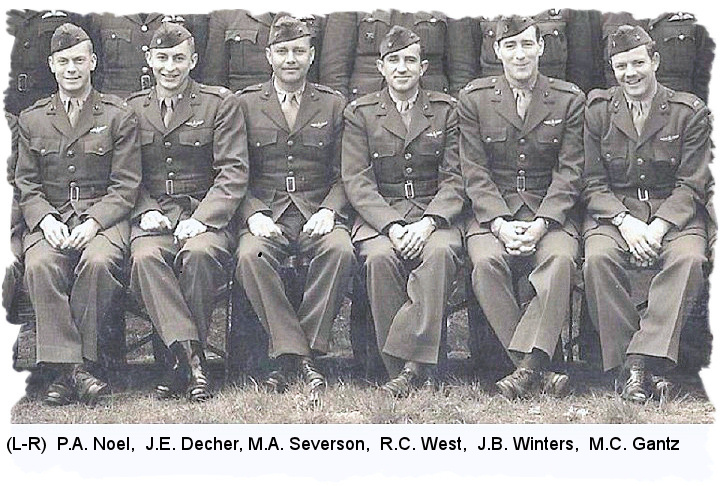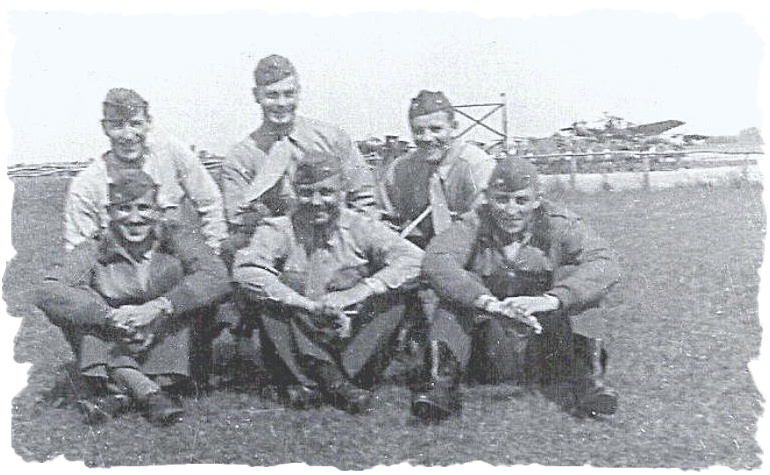Paul A. Noel, Jr.
Luck of the Draw by Paul A. Noel, Jr.
Dear Cousin Max, as family historian you inquired why/how I, a Marine Naval Aviator, found myself in London in 1944 in the midst of a German V-1 attack. It is a long story with several sub-plots. Lots of folks, including Marines, have also wondered. Here is my story of early Marine Aviation Night Fighters as I recall events.
The first Marine Night Fighter Squadron was commissioned in 1942; aircraft assigned were Lockheed-Vega PV-1, Venturas, a twin engine Navy land based patrol bomber developed from the pre-war Loadstar transport; not a very auspicious beginning for a fighter squadron aircraft.
Marine Air, except for daily flight operations, was totally equipped and directed by the U. S. Navy. The term Naval, as in Naval Aviation, includes USMC+US Navy. This is a very fine, misunderstood point and the basis for the incorrect remark 'the Marine Corps is part of the Navy'. Minor detail---back on course. The Marine squadron, VMF(N) 531, was deployed and active in the Guadalcanal campaign.
At the same time the Navy and the Marines were commissioning single engine, single pilot night fighter squadrons, F6F Hellcats and F4U Corsairs, that could operate from a carrier. Obviously these pilots operated their own radar. So two camps, or two concepts, were in play based on man vs machine. Some pilots did not want a radar operator, or any one else, telling what to do; like climb, slow down, turn port, hard port, etc. The other school of thought was happy to let an expert tweak and twiddle the tube and get the pilot into an attack position while the pilot spent 100% of his time flying the aircraft on instruments and then visual identification of the intercepted Bogie.
Early on (1942?) a new twin engine, two man crew night fighter was developed by Grumman at Navy request------the F7F Tigercat.
In 1943 the Marine Corps sent five Naval Aviators (NA) and five enlisted, often referred to as RAF Cadre #1, to England/RAF for night fighter training, not only in flight tactics but to literally copy the RAF early warning system, ground control intercept system, and the control centers/rooms (like we see in RAF movies with the WAAFs pushing card board airplanes around on a large map). These Marines helped to build the Marine system when they returned CONUS May 1943.
This operation was so successful it was decided to repeat the program in 1944; send six Marine crews, Cadre #2, but for night air tactics only, as the nucleus for the F7F Tigercat squadrons now in the planning stage. (Side bar: the Navy also sent five crews, 30 days behind USMC in the pipe line. They lost three crews--another story for another time.)
The Cadre #2 senior officer, who happened to be in HqMC, selected the other five NAs, one of which was also in Hq. So there are four slots open.
There was a concurrent argument whether it is best to to take a qualified single engine fighter pilot and convert to twin engine operation with a radar operator or take a highly skilled twin engine instrument pilot from a R4D transport squadron and convert to a fighter pilot. The latter argument prevailed.
Four slots and then one was filled by a young major who was training in PBJs.
Three slots open! The Cadre #2 OIC LtCol went from Hq to MCAS, Cherry Point where a previous squadron mate from pre-WWII MCAS, St. Thomas was now CO of the transport squadron, to select one Capt and two 1Lts to complete the cadre NA roster. The transport CO called in his Chief of Flight and explained the problem. The Capt said, 'I'll take the Capt slot' and he then provided the names of four 1Lts for interview.
I was ordered to report to the COs office, not ever a happy summons, and was interviewed cold; no time to reflect, study, or spruce up---just a pilot from the ready room. As you can guess, I was one of the two 1Lts selected to join the cadre. Luck of the draw!
We departed NYC 1 April 1944, via PanAm Clipper wearing civilian clothing and carrying a pass port identifying us as Government officials on government business because scheduled stops included Azores, Lisbon, and Ireland, all so-called neutral areas.
Cuz, as a 20 year old 1Lt, Aircraft Commander, and Instructor in type I could make a R4D dance. No surprize as when I graduated Pensacola I went to American Airlines School, Fort Worth, a 30 day course to check out in the R4D. The instructors were all senior AA captains. My instructor cut his aviation transport teeth flying Ford Tri-motors, TNT cargo, into the Andes mining areas. Boy, was he good! About four classes before me the grads would actually go to an airline for 90 days as co-pilots, some on passenger routes. The problem was suddenly a lot of folks in the Reserves were called up creating a big shortage of line pilots. That would have been heavy duty for a then 19 year old! Cuz, just think of all those stews! Tally-ho!!!
With my demeanor most of my R4D squadron mates thought I was at least 25-27 years old. At that time any one in uniform could buy a drink so there was no tip off I was a kid. In fact, with friends I was sometimes referred to as 'The Kid', which was extremely galling if there were 24-25 year old honeys around. Today' The Kid', now aka Dino as in dinosaur, is still here and my peers are awaiting my join-up at that big Happy Hour in the sky.
But I digress again---back on course---
The Brits make a big deal of the importance of the night fighter team compatibility; pretty much 'live, work, and play together'. In fact, the Brits refer to the teaming as a 'marriage'. We had not met our six enlisted, two TSgts and four SSgts, until arrival in England. Their qualification were combat crew vets. All were SBD rear seat gunners from Guadalcanal (all promoted to Warrant Officers upon return CONUS). Our "Marriage" was typical MarCorps. LtCol made two lists by seniority, matched the lists, and pronounced "you are now a team"!
When we graduated from RAF Operational Training and certified combat ready, the RAF would only take two crews for posting to 219 Squadron, flying Mosquitoes equipped with latest engines and radar. Our OIC, quite an Old Corps Wheeler-Dealer managed, 'under the table', to get the USAF to take one crew in a P-61 squadron enroute to Normandy. He took that slot, l later apologizing because he could not swing a deal for three crews and therefore had to slough two crews off on the RAF.
The dinosaur personnel selection process is cranked up again with the announcement the two Lts would take the RAF slots and the OIC would take the P-61 slot. That was OK but I noted the two Lts were the only bachelors------three married aviators volunteered to make the sacrifice and return to families in CONUS!!! Luck of the draw!!!
Max, every thing I ever needed to know about Personnel Management I learned in Cadre #2!!!
The saga continues: While in England we were under Embassy control via Naval Attache for Air. At completion of RAF training we returned to HqMC for further orders. . The two old timers were smart and left us high and dry as they wrangled orders to the Pacific. The junior major and the three JOs got orders to the Marine Night Fighter Operational Training Detachment, NAS, Vero Beach, FL. Vero conducted all Navy-Marine night fighter training; the Navy ran the single engine and Marines ran twin engine and RO schools. An exact duplicate of the RAF system, including WAVES in Control room pushing around card board airplanes, had been set up by a member of the 1943 Cadre. Cuz, it sounded perfect! Halleluja VMF(N)! Hello F7F!!!!
Wrong!!! What we four naive types did not realize, at least the JOs did not, was despite the name, we were under Navy control, as in Navy (not Naval) Operational Training Command with HQ in Jacksonville, FL. Remember above I made a big deal out of Navy controlling Marine Air except MarCorps daily flight operations?
The gist was we were locked in as instructors for two years and not a day less. So, instead of being part of the first Marine F7F night fighter squadrons, we trained the Marine crews who went to the Night Fighter Group at MCAS, Eagle Mountain Lake, Tx and formed the F7F squadrons for Pacific deployment. It would have been Nov 1946 before I was sprung lose. The war ended and my career path has a gap of no Pacific duty. Similar parellel in 1951 and I got locked in ONI for two years as they were forming the first Marine jet night fighter cadre with scheduled deployment to Korea. Luck of the draw, Cuz. Sometimes good, sometimes not so good!!!
Just in time for the last class, Dona's brother showed up at Vero as a Radar Operator student and we hung out together.
Later he and I teamed and flew together for a couple months. If he had not appeared I doubt she and I would have gotten hitched as I had sort of lost track of the family. Yep, luck of the draw!!!!!
Shift gears Max! Now fifteen years after England, cc 1958. I was a Major assigned to Aviation Training, HqMC. One Friday afternoon, about 1430, the AvnOps folks received a phone call from CNO that there was to be a meeting at the Pentagon in about 45 minutes regarding All-Weather Fighters. The Navy was infamous for waiting until the last moment, thus not allowing any prep time, or even 'forgetting' to invite Marine Air to important meetings.
No one in their right mind would want to go to the Pentagon from Arlington Annex for a late Friday afternoon meeting----mess up TGIF plans, week-end, etc. So Lucky Pierre and another Major were directed to attend. No other information regarding subject or 'position'; "just show the flag"!!!
Luck of the draw!!!
It turned out to be THE COMMITTEE to make final CNO recommendation to SecNav for purchase of the All Weather Fighter of the future; actually F4 vs F8!!!!! I did not blink an eye or even listen to the pitch by the marketing lads from McDonnell or Chance Vought. "After much deliberation"------ya chur----I cast a vote to drive a stake in the immediate future of single engine-single pilot all-weather fighters!!!!! Luck of the draw!!!
There still may be some long toothed F8 drivers hobbleing around wondering 'Wha' happened'? Monday morning no one even asked about the meeting and I never volunteered a word. But as you can tell, I AM STILL GLOATING!!!!!!!
Cuz, the short answer to your query "What was I doing in England?"---Luck of the draw!!!
And so it goes! Yachi-dah! (Welsh; Cheers)!
Your cousin, Paul





